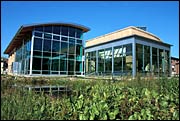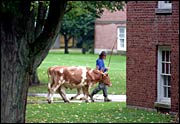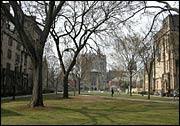See which colleges got top marks from Grist, then grade our effort in the comments section at the bottom of this page.

College of the Atlantic
This small school in Bar Harbor, Maine, has just one major: human ecology — or “the study of our relationship with our environment.” So it only makes sense that it was the first college in the U.S. to pledge carbon neutrality. And it kicked off quite a trend: Now more than 270 other U.S. colleges and universities — including many of the following — have pledged to do the same as part of the American College & University Presidents Climate Commitment.

Middlebury College
This Vermont college is a hotbed of climate activism. Student group MiddShift pushed the board of trustees to approve a plan to make the school carbon-neutral by 2016. Students have also led the charge to host energy-saving contests in residence halls, increase use of public transportation to and from campus, and turn down campus thermostats. A handful of students and recent alums, along with scholar-in-residence Bill McKibben, helped organize the Step It Up 2007 campaign demanding action to fight climate change, and now a Middlebury delegation has joined up with the Climate Summer campaign in New Hampshire.

EARTH University
This appropriately monikered university in Costa Rica is dedicated to promoting sustainable development in the tropics. Students from more than 20 different countries go through a four-year program to earn an agronomy degree as they learn to balance ecological preservation and agriculture. EARTH University’s “rational use of resources” program aims to instill an eco-ethic in everyone on campus.

The Evergreen State College
True to its roots — and its name — this Washington state school maintains a strong commitment to sustainability: An organic farm, almost an acre in size, produces enough food to have leftovers after selling to the campus food service, and proceeds go into financing farm projects and other student endeavors. A massive composting program is also in place — complete with a compost reactor, worm bins, and food-scrap collection at residence halls. And after students voted to approve a fee increase, the school was able to purchase 100 percent (ever)green power.

Oberlin College
Hoping to get an ober-view of energy use, faculty and students at this small liberal arts college in Oberlin, Ohio, collaborated in 2005 to create a web-based monitoring system in some of the dorms that shows how much energy and water is being used, giving students real-time feedback that can help change their consumption habits. Last year, students worked with Cleveland-based CityWheels to create a car-sharing program on campus. The college’s Adam Joseph Lewis Center for Environmental Studies is housed in a pioneering green building that opened in 2000. Oberlin also boasts Ohio’s largest solar array and is transitioning to 100 percent earth-friendly cleaning products.

News Office
Harvard University
This Ivy Leaguer began a Green Campus Initiative in 2000 and has continued to grow its green roots [PDF] since then. Harvard has made major investments in energy conservation in campus buildings, introduced a green cleaning service, and integrated local and organic produce into school cafeterias. Plus, 20 new-construction and renovation projects have been certified for green credits since 2002, more than at any other university in the country. The Crimson’s green tide is also extending to transportation, with biodiesel being made from kitchen oil and used in university buses.

University of British Columbia
A leader in the greening of Canadian campuses, UBC adopted a sustainable development policy in 1997 and a year later opened a campus Sustainability Office — both firsts for the nation’s colleges. Offering more than 300 sustainability-related courses, this Vancouver campus was Canada’s first and only university to receive Campus Ecology Recognition from the U.S.-based National Wildlife Federation, in 2003 and again in 2005. And just last year, UBC developed a comprehensive sustainability strategy to keep the eco-momentum moving.

California State University, Chico
This year, Chico State won grand prize in the National Wildlife Federation’s Chill Out competition, which challenges colleges to find effective ways to fight global warming. Chico State’s dedication to sustainability also includes LEED-certified buildings and solar arrays atop some campus rooftops, and students have taken up the charge with energy-saving projects and sustainability-minded service-learning programs.

Tufts University
Tufts is getting tough on climate change. It has committed to meeting or exceeding the Kyoto target for emissions reductions, and it was the first university to join the Chicago Climate Exchange. The Tufts Climate Initiative won the U.S. EPA Climate Protection Award in 2005. The university has a strong history of incorporating sustainability throughout its operations and campuses.

Leeds University
The U.K.’s second-largest university, Leeds is a leader in eco-friendly waste management, and the school’s work in that area has won it a Green Gown Award [PDF] from U.K.-based HEEPI (Higher Education – Environmental Performance Improvement). By replacing trash bins with recycling containers, it doubled the amount of recycling happening on campus. The school has also changed its purchasing practices to favor recycled goods.

Green Mountain College
Calling itself “Vermont’s environmental liberal arts college,” GMC uses the environment as a central theme in its core curriculum. Also central to its operation? Methane from nearby dairy farms that provides half of the school’s electricity. Additionally, GMC’s efforts to save energy helped earn it the first Energy Star Showcase Campus award from the U.S. EPA in 1999.

Yale University
Yale President Richard Levin wants to make his school the greenest in the U.S. The university has committed to reducing greenhouse-gas emissions to 10 percent below 1990 levels by the year 2020. (Hello, DIY Kyoto.) To reach its goal, it plans to tap into renewable sources of energy, purchase carbon offsets, make its energy systems more efficient, and build new buildings greenly. Taking the commitment even further, the university hopes to aid China in reducing greenhouse-gas emissions and educating its leaders on environmental issues.

Aquinas College
When it comes to sustainability, this Grand Rapids, Mich., school gets right down to business. Literally. Aquinas bills itself as the first college to offer an undergraduate major in sustainable business — a four-year curriculum that combines formal biz training with environmental studies. Growing interest in green biz led to the creation of the Center for Sustainability, an online resource center.

Glasgow
Glasgow University
The first Scottish university to get energy-efficiency accreditation (in 1998), Glasgow draws almost 45 percent of its electricity from renewable sources and is constantly on the lookout for new ways to reduce overall energy use. Recognized by HEEPI for its sustainable procurement practices [PDF], the school has ensured that construction of new buildings involves energy assessments and energy-saving designs.

University of Maryland
Students at this College Park campus recently sent a loud-and-clear message about sustainability: some 91 percent of undergrads voted to raise student fees in order to pay for clean energy, when tuition and fees are already at record highs. If implemented, the fee increase would eventually raise enough money to make UM the largest higher-ed purchaser of renewable energy in the U.S. UM — one of the many schools committed to going carbon neutral — is also doing what it can to reduce energy use: a combined heat-and-power plant completed in 2003 received the U.S. EPA’s Energy Star award, and motion sensors that automatically shut down unused office equipment are currently undergoing testing.
Runners-Up

Photographic Services
University of New Hampshire
Forget organic eaters, the University of New Hampshire hopes to educate future organic farmers with a multimillion-dollar dairy farm on 30 acres near Lee, N.H. The project is funded in part by Stonyfield Farm, an organic yogurt maker based in the state. As part of the school’s effort to be a Climate Protection Campus, UNH also sponsors programs like WildCAP, which offers student discounts on Energy Star and other energy-efficient products.

Stanford News Service
Stanford University
The school’s recently built Global Ecology Research Center was named one of the American Institute of Architects’ Top 10 Green Projects in 2007. The two-story structure features walls made of redwood salvaged from century-old wine casks, rainwater collection, and a number of recycled building materials. Stanford’s cutting-edge climate and energy research has also garnered quite a bit of interest (and some controversy); the university had to turn away attendees at a recent student-organized renewable-energy symposium that attracted more than twice as many people as expected.

Arizona State University
With one of the nation’s largest enrollments on a single campus, sustainability is a huge issue for ASU. And it’s a degree program, too, via the newly opened (and world’s first) School of Sustainability, which will serve both undergraduate and graduate students. Located in the Phoenix area, ASU is well aware of the effects global warming could have on the city’s hot, dry clime — which is why the school’s Biodesign Institute will focus on emulating natural systems to innovate for tomorrow’s environment.

University of California, Berkeley
Last year, UC-Berkeley served up an organic salad bar. Though many schools are moving in this direction, Berkeley’s dining hall is the first in the nation to feature an officially certified organic kitchen. And it’s not just food these students are hungry for: demand for introductory energy courses at Berkeley has almost tripled in recent years.

St. Olaf College
Is this Minnesota school into sustainability? Ya sure, you betcha. For 2005-2006, it was the theme for the whole school year, making its way into courses, lectures, and campus tours. A “college of the church,” St. Olaf is invested in creation care from a spiritual standpoint as well and created a black & gold & green website to give “an honest accounting of [its] successes and failures” in sustainability.
Sarah van Schagen contributed to this list.


